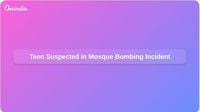On November 8, 2025, the Kelapa Gading district of Jakarta, Indonesia, was shaken by a series of explosions during Friday prayers at a mosque located within a school complex. The blasts, which left 96 people injured, have sent shockwaves through the world’s largest Muslim-majority nation—a country where attacks on places of worship are exceedingly rare and often met with deep public dismay.
Authorities quickly began piecing together what happened that day. According to Reuters, police recovered seven improvised explosive devices in and around the mosque. Some of these makeshift bombs were hidden in soda cans, while others were cobbled together using simple materials like 6-volt batteries, plastic jerry cans, remote controls, and sharp nails. Four of the devices detonated—causing the bulk of the injuries—while three failed to explode and were later secured by the police. Investigators also found a toy submachine gun at the scene, marked with the word “vengeance” and adorned with white supremacist slogans and the names of infamous extremists.
The suspect at the heart of the incident is a 17-year-old student from a nearby school. His identity remains protected under Indonesian law, which treats minors with particular care in criminal proceedings. Jakarta police chief Asep Edi Suheri referred to him as a “child facing the law,” underscoring the sensitivity and complexity of the case. The student, who was among those injured in the blasts, is currently recovering after undergoing two surgeries for a head injury sustained during the explosions, as reported by multiple agencies.
As details emerged, the story behind the attack became both more troubling and more familiar in the context of global trends. Mayndra Eka Wardhana, a senior official with Indonesia’s anti-terror unit, described the suspect as “a lone actor motivated by vengeance and loneliness.” The teenager, it turns out, had been deeply influenced by violent online communities and had developed an obsession with extremist content. He reportedly admired neo-Nazi and white supremacist attackers, but investigators found no evidence that he belonged to any organized militant group or that he subscribed to a particular ideology beyond a grim fascination with violence.
“That inspired the alleged perpetrator,” Wardhana told reporters, noting that the student had drawn particular inspiration from the 2019 mosque shootings in Christchurch, New Zealand, and the 1999 Columbine High School massacre in the United States. The toy gun found at the scene bore not only slogans but also the names of international extremists, including neo-Nazis involved in attacks in Canada and Italy. “Those symbols and names are just violent figures and ideology that inspired the teenager to copycat,” Wardhana explained, according to the police counterterrorism squad.
Police Director of General Criminal Investigation Iman Imanuddin added further insight into the suspect’s psychological state. “This boy had been motivated to launch such an action,” Imanuddin stated, emphasizing that the student felt isolated and lacked an outlet for his grievances at home, at school, or within his broader community. The suspect’s sense of alienation and his immersion in online extremism seem to have formed a dangerous cocktail, fueling his decision to act alone.
Henik Maryanto from the police mobile brigade unit detailed how the bombs were assembled. The student followed online instructions to build the devices, relying on everyday materials that could be easily sourced and concealed. “We have secured the remaining active bombs that failed to explode,” Maryanto said, highlighting the ongoing risk and the meticulous work required to prevent further harm.
The aftermath of the attack has been severe, particularly for the young students who were present in the mosque at the time. More than half of the 96 injured suffered some degree of hearing loss, with four experiencing sudden, total deafness. As of November 11, eleven students remained hospitalized, including one who was critically injured by burns. The human toll is a stark reminder of the indiscriminate nature of such violence and the vulnerability of communal spaces meant for peace and reflection.
Legal proceedings in the case are complicated by the suspect’s age. Despite the gravity of the attack, he cannot be charged under Indonesia’s strict anti-terrorism law because of his status as a minor. Nevertheless, authorities are considering charging him with premeditated serious assault, a crime that carries a potential sentence of up to 12 years in prison. The legal debate underscores the challenges faced by societies worldwide when dealing with youthful perpetrators of grave crimes, especially when those acts are inspired by ideologies encountered in the digital wilds of the internet.
The incident has prompted a broader investigation and a period of soul-searching for Indonesia. Attacks on places of worship are, thankfully, rare in the country, and the fact that this one was perpetrated by a teenager acting alone—motivated not by local grievances or organized networks, but by global currents of online extremism—has many officials and community leaders deeply concerned. The case has highlighted the growing challenge of so-called “lone-wolf” attacks, in which individuals, often young and isolated, are radicalized through exposure to violent ideologies online and then act without the support or direction of established terrorist groups.
“He felt there was no place to share his complaints, neither with his family nor school,” Wardhana said, painting a picture of a young person adrift and vulnerable to the worst the internet has to offer. The attack has renewed calls for greater vigilance in monitoring online spaces and providing support systems for youth who may be struggling with isolation, anger, or extremist influences.
For Indonesia, a nation proud of its tradition of religious pluralism and community resilience, the Kelapa Gading mosque bombing is a painful episode—one that will likely spark debates about youth mental health, digital safety, and the adequacy of legal frameworks for addressing new forms of violence. As the investigation continues and the community works to heal, the hope is that lessons learned from this tragedy will help prevent similar incidents in the future.
The story of the 17-year-old suspect is a cautionary tale for societies everywhere: in an age when violent ideologies can cross borders with the click of a mouse, the dangers of loneliness, alienation, and unchecked online influence are as real as any physical threat. For now, Jakarta’s residents are left to grapple with the aftermath—and to ask hard questions about what more can be done to protect the country’s youth and its sacred spaces from such senseless acts.




